19th Livestock Census of India – An Overview
Oct 15, 2014
Adapted from the “19 Livestock Census-2012 All India Report”1 published by the Ministry of Agriculture, Department of Animal Husbandry, Dairying and Fisheries, Krishi Bhawan, New Delhi
The Animal Husbandry and livestock sectors are critical for India’s rural economy, especially the small and marginal farmers and the landless. They not only contribute to their income and household nutrition, but are also their best insurance against any emergent need.
The livestock census in India is carried out once every five years. The 19th livestock census was carried out in 2012 and encompassed all States and Union Territories covering all villages, towns and wards in the country.
As compared to the 18th Livestock Census, there has been an overall decline of 3.33 percent in the total livestock population in the country. The total livestock population including cattle, buffaloes, sheep, goat, pigs, horses and ponies, mules, donkeys, camels, mithun and yaks, was 512.05 million in 2012. The total poultry population, including fowls, ducks, turkeys and others, was 729.2 million.
While there has been an overall decline in the total livestock population in the country, some States have recorded substantial increases in livestock numbers. These are:
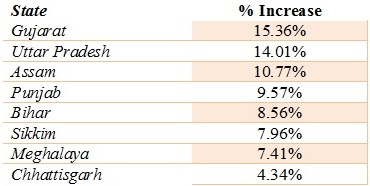
The total Bovine (cattle, buffalo, mithun and yak) population shows a decline of 1.57% as compared to the 2007 census. However, the milch animals (in-milk2 and dry3) in cows and buffaloes have increased by 6.75%. At the same time, the numbers of female cows and buffaloes have increased by 6.52% and 7.99% respectively. The total buffalo population has shown a growth of 3.19% and milch buffaloes by 4.95%. The exotic/crossbred milch cattle has shown a substantial increase of 34.78%. In comparison, the indigenous milch cattle has increased only marginally by 0.17%.
While the Mithun population in the country has registered a growth of 12.98%, the Yak population has had a negative growth rate of 7.64%.
The population of horses and ponies has increased by 2.08% and that of mules by 43.34%. At the same time the camel population has decreased by 22.48%, pigs by 7.54% and donkeys by 27.22%.
The percentage distribution of the livestock population of the country is as follows:

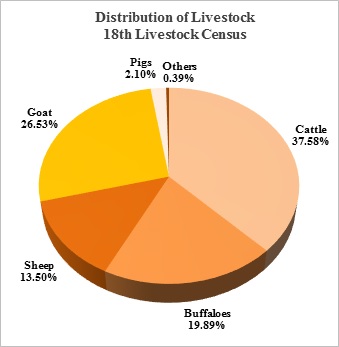
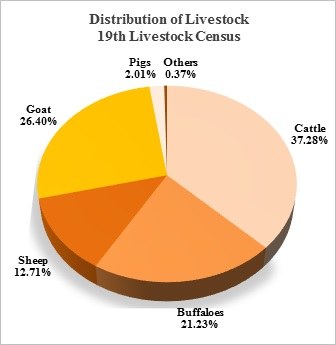
Small Ruminants (Sheep and Goat)
The 19th Livestock Census of 2012 has shown a decline in the sheep population in the country of 9.07% over the 2007 census. The total sheep in the country are 65.06 million. Similarly, the goat population has declined by 3.82% over the 2007 census and the total numbers recorded are 135.17 million.
The sheep population constitutes 12.71% (65 million) of the total livestock population in the country.
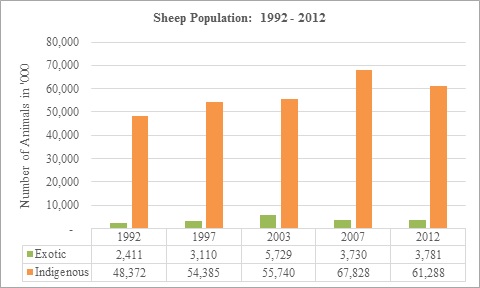
Goats constitute 26.40% of the total livestock population and the 19th Livestock Census puts the number of goats in the country at 135.17 million.
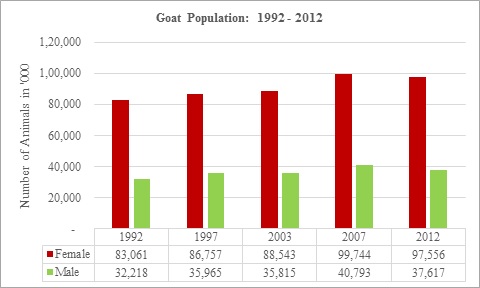
A State-wise breakup of the sheep and goat population in the country is given below:
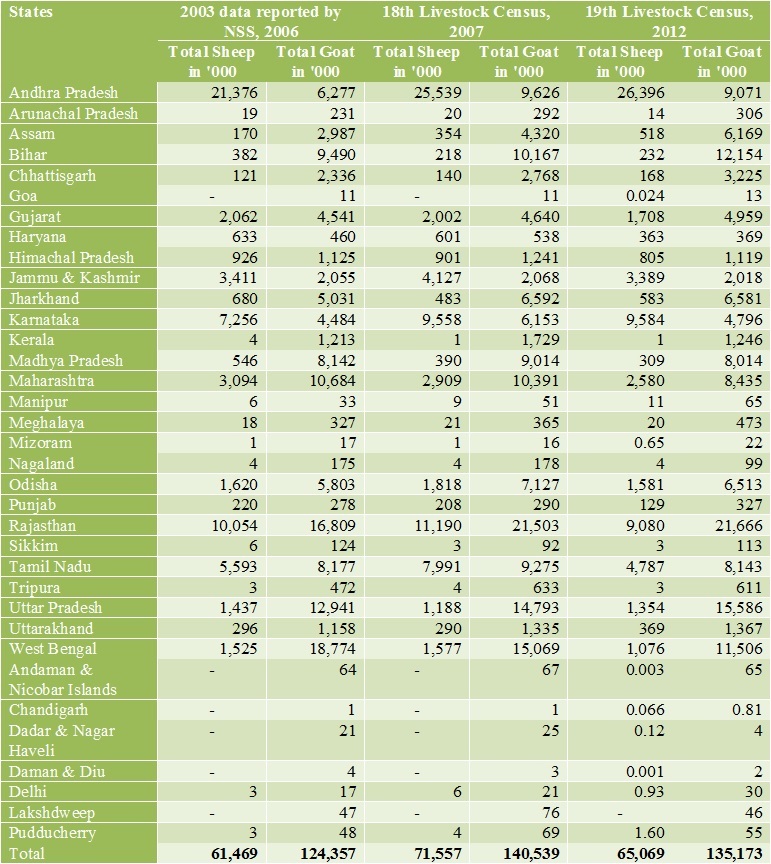
The total number of households and household enterprises4, both rural and urban, which rear/own sheep are 4,552,119 and goat are 33,014,087. Similarly, non-household enterprises5 and institutions6 which rear/own sheep are 8,010 and goat are 25,189.
Poultry
Three categories are included in Poultry, namely, Fowls, Ducks and Turkey and others. The 19th Livestock Census reports the country’s population to be 729.2 million. This is an increase of 12.39% over the 2007 census figures.
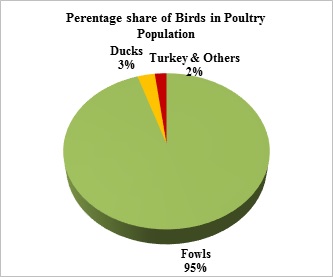
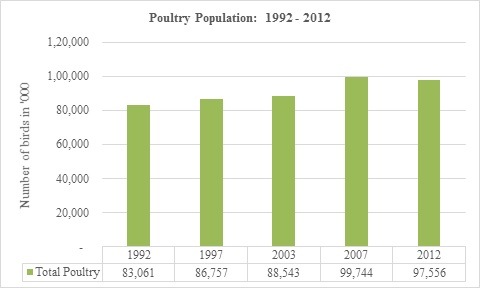
The total number of desi and improved fowls7 (rural and urban) are 163.84 million and 32.4 million respectively. The number of households and household enterprises rearing backyard poultry are 30,316,024 and in poultry farms8/hatcheries are 20,023,244. Similarly, number of non-household enterprises and institutions rearing poultry in farms and hatcheries are 2,429,256.
References:
- Available at http://dahd.nic.in/dahd/WriteReadData/Livestock.pdf
- Animals producing milk are described as animals ‘in milk’.
- Animals which are calved but at present not producing milk are described as dry animals. Animals that cannot be calved in future are not covered under this category.
- A household enterprise is one which is run by one or more members of a household or run jointly by two or more households on partnership basis irrespective of whether the enterprise is located in the premises of the household or not.
- A non-household enterprises is one which is institutional i.e. owned and run by the public sector (Central or State Government, local bodies, government undertakings, etc.), private corporate sector (include public and private limited companies registered as joint stock companies under the Companies Act 1956), Co-operative societies, other type of societies, institutions, associations, trusts, etc.
- For the purpose of the 19th Livestock Census, Temples, Mosques, Gurudwara, etc. have been covered under Institutions.
- ‘Desi’ and ‘improved’ poultry birds: If a hen/duck lays more than 100 eggs in a year then it is categorized as ‘improved’ hen/duck or else it is categorized as ‘desi’. If a cock/ chicken/ drake/ duckling falls into the flock of an ‘improved’ hen/duck then it an ‘improved’ cock/ chicken/ drake/ duckling or else it is ‘desi’.
- Farms having more than 1,000 birds are considered as Poultry Farms. Farms which have only Emu/Ostrich birds will be considered a farm if they have more than 20 birds. However, all government enterprises which have poultry are considered as poultry farms irrespective of the number of birds in them.









